Bryanna Clark Grogan’s Vegan Feast Kitchen/ 21st Century Table: The kitchen journal of a vegan food writer.. I'm on Facebook and Twitter (see links in sidebar at right).
Sunday, April 19, 2009
GOOD VEGAN MEALS ON THE WW CORE PLAN; LOW-FAT TIP; & UPDATE ON NONSTICK SKILLETS

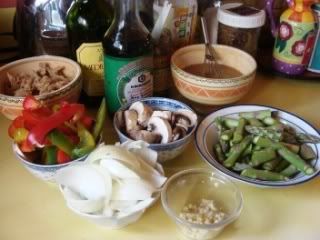 The ingredients for a delicious stir-fry using what I had available, and what needed using up.
The ingredients for a delicious stir-fry using what I had available, and what needed using up.DH and I have been on the Core Plan for almost 3 weeks now and have done pretty well, even with Easter and eating out a few times. I'd like to share some of the meals we've had (that I photographed, anyway!), and a tip for cutting down on oil. You will see that I DO use my own cookbooks!
One day we just HAD to have some Pasta alla Puttanesca, and it fit right into the plan! I used whole wheat pasta

One night I decided to have an Asian version of "weiners and cabbage"-- stir fried veggie weiner slices (I use the Yves Veggie "Bavarian Sausages") with Brussels sprouts. It was delish! I was a remake of a recipe for stir-fried weiners and cabbage that I used to make over 40 years ago:

We took this Vegan "Chicken" Caesar Salad to a dinner party at a friend's house, to rave reviews. I used reconstituted Soy Curls® stir-fried with chopped garlic (no oil) for the "chicken", the Caesar Dressing that's in my books "Soyfoods Cooking for a Positive Menopause
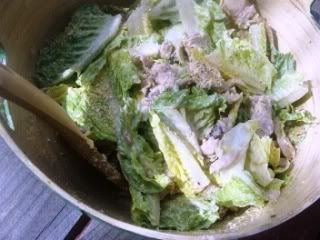
Another day I made a big pot of Vegetarian Feijoada (Brazilian Black Beans-- the recipe is in my books "The Almost-No-Fat Holiday Cookbook"
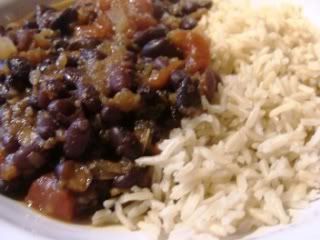
Then I made my Spicy Mexican Bean Dip (or "Refried Beans") with some of the pot (the recipe for the dip is in several of my books), which we used as a dip for veggies, and also in some tacos. I froze the rest of the beans for future meals.
I made a variation one night on my Asparagus Tofu with Black Bean Sauce from my book "Authentic Chinese Cuisine for the Contemporary Kitchen" , using ingredients that needed using up and that I had on hand (see photo at top of his blog post). I used I used reconstituted Soy Curls® instead of tofu, because I had just the right amount in the fridge:
, using ingredients that needed using up and that I had on hand (see photo at top of his blog post). I used I used reconstituted Soy Curls® instead of tofu, because I had just the right amount in the fridge:
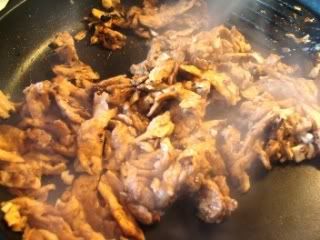
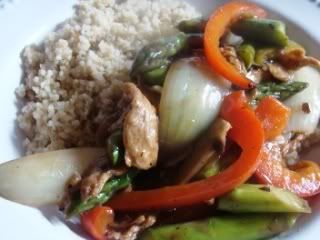
Instead of rice, we ate the stir-fry with a mixture of steamed bulgur and quinoa:
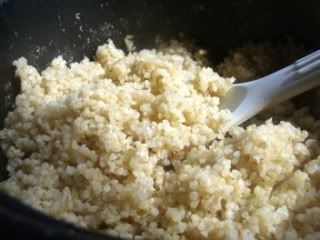
I really like this mixture (it's cheaper than quinoa only, too), and we use it alot instead of rice on the Core Plan. I make it in my electric rice cooker. I just cook 1 part medium bulgur , 1 part quinoa
, 1 part quinoa , 4 parts water, and a little salt. I make quite a bit at a time and freeze portions of it to microwave for quick meals.
, 4 parts water, and a little salt. I make quite a bit at a time and freeze portions of it to microwave for quick meals.
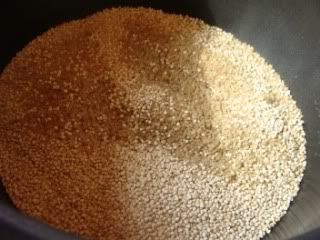
Quinoa and bulgur in the rice cooker.
One evening we had a lovely Syrian Tomato and Cucumber Salad with Mint (using our daily quota of olive oil and olives!), a recipe from Habeeb Salloum's lovely book, "Arab Cooking on a Saskatchewan Homestead ": Recipes and Recollections" (you can read more about it at this blog post):
": Recipes and Recollections" (you can read more about it at this blog post):

One recent meal was a virtually-fat-free version of my Vegan "Chicken" Divan Casserole (I wrote about it and gave the original recipe in this blog post). I had a whole bunch of broccoli to use up and felt like something "homey" and comforting. I stir-fried the Soy Curls® with the garlic in a nonstick pan, and I omitted the fat from my Vegan Bechamel Sauce (just blended the flour in with the ingredients and cooked it in the microwave). I omitted the bread crumb topping and used a light sprinkling of my New, Improved Okara Parmesan Substitute. I didn't have any vegan cheese handy to grate, so I made my easy Melty Chedda Cheeze (2 x the recipe, from my book "20 Minutes to Dinner"), also in the microwave, just before assembling the casserole, and drizzled half of it in the middle:
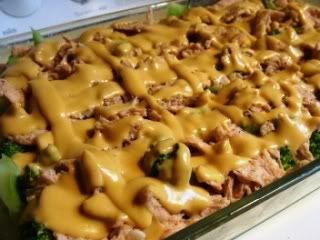
and half of it on the top, covered with the Okara Parmesan sprinkle. It came out very well! The Bechamel puffed up nicely during the baking:
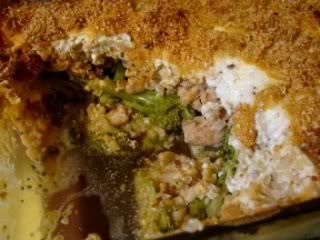
Here's a little preview of an upcoming post I'm working on about using chickpea flour for various treats. This was my first attempt at making Panella, which is a sort of deep-fried Italian chickpea polenta, only I oven-fried it. It was too thin, but otherwise very tasty:
for various treats. This was my first attempt at making Panella, which is a sort of deep-fried Italian chickpea polenta, only I oven-fried it. It was too thin, but otherwise very tasty:
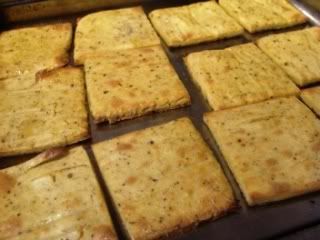
One night we had a craving for peanut sauce, and some fresh spinach to use up, so I made low-fat version of my Thai-Style Spinach and Tofu with Peanut Sauce. The only changes I made to the recipe were to omit the 1 tsp. sesame oil and to dry-fry the tofu in a nonstick skillet instead of frying it in oil (you could also brown them on a cookie sheet under the broiler). The peanut butter made up our daily fat ration.
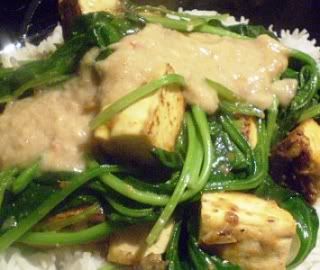
Today for lunch we had my vegan Minestrone alla Milanese (from my book "Nonna's Italian Kitchen" ). I used cooked brown Basmati rice in it and used no oil:
). I used cooked brown Basmati rice in it and used no oil:
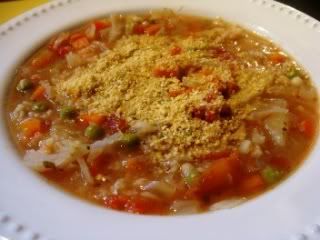
A FAT-SAVING TIP:
The way I saved on oil in the Minestrone recipe was something that I use frequently-- I "sweat", soften or "steam-fry" (saute without oil) the onions, and other chopped or sliced veggies, in a covered Pyrex casserole or pie plate in the microwave. Then you can use your oil or fat ration in a more interesting way-- a salad dressing or whatever. (PS: If you are afraid of using a microwave, please read this compilation of info.)
Microwave option for “sweating” the vegetables: Spray a microwave-safe pie plate or casserole lightly with oil from a pump sprayer , add the chopped or sliced vegetables.
, add the chopped or sliced vegetables.
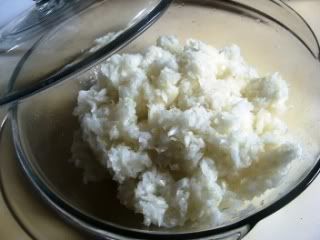
Cook the mixture on high power for about 5 minutes, covered with a microwave-safe lid, plate or pie plate. If you are doing alot at one time, you might need 10 or more minutes. Cook until they are softened.
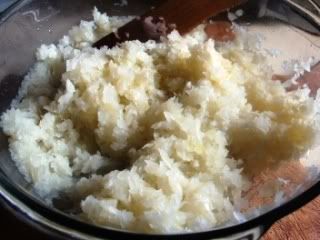
(To "sweat" vegetables with no oil on the stove-top: Spray a sturdy nonstick skillet lightly with oil from a pump sprayer, heat over high heat, then add the chopped or sliced vegetables. Stir-fry for a few minutes over high heat, then reduce the heat, cover the pan and cook gently over low heat for 5 to 10 minutes to soften the vegetables.)
lightly with oil from a pump sprayer, heat over high heat, then add the chopped or sliced vegetables. Stir-fry for a few minutes over high heat, then reduce the heat, cover the pan and cook gently over low heat for 5 to 10 minutes to soften the vegetables.)
I made the following soup using this method to cook the leeks, onions, and garlic:
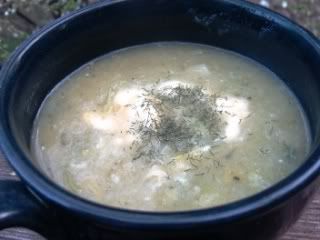
Printable Recipe
BRYANNA'S FAT-FREE CREAMY LEEK AND POTATO SOUP
Servings: 4
A very easy and deliciously rich-tasting leek soup. I like the green parts of the leek, so I use them as well as the white part.
3 medium leeks, cleaned and sliced thinly crosswise
1 small onion, chopped
4 cloves garlic, chopped
1 teaspoon coarse salt
1/2 teaspoon dried thyme leaves
4 cups good vegetarian chicken-style broth
2 cups (@ 12 oz.) diced, peeled Yukon Gold potatoes (or Russets, in a pinch!)
1 small bay leaf
Garnishes:
a few tablespoons minced fresh parsley (or dill)
Tofu Sour Creme (Tofutti or homemade)
freshly-ground black pepper
Combine the white part of the leeks with the onion, garlic, coarse salt and thyme in a Pyrex casserole sprayed lightly with oil from a pump sprayer
sprayed lightly with oil from a pump sprayer . Cover and microwave on High for 10 minutes. (Or use the Stove-Top Method above.)
. Cover and microwave on High for 10 minutes. (Or use the Stove-Top Method above.)
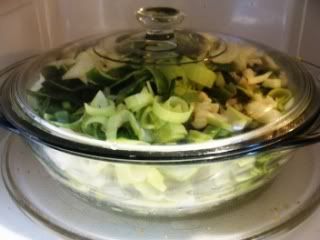
In a heavy soup pot , mix about half of the leek-onion mixture (reserve the rest) with the broth, potatoes and bay leaf and bring to a boil, then reduce the heat to a simmer. Cover and cook about 15 minutes, or until the potatoes are tender.
, mix about half of the leek-onion mixture (reserve the rest) with the broth, potatoes and bay leaf and bring to a boil, then reduce the heat to a simmer. Cover and cook about 15 minutes, or until the potatoes are tender.
Remove the bay leaf from the pot and discard. Blend the soup right in the pot with a stick/immersion blender until smooth. Add the reserved cooked leek mixture and stir briefly. Taste for salt and pepper.
until smooth. Add the reserved cooked leek mixture and stir briefly. Taste for salt and pepper.
Serve immediately, garnished as you wish.
Nutrition Facts
Nutrition (per serving): 134.0 calories; 1% calories from fat; 0.2g total fat; 0.0mg cholesterol; 1179.7mg sodium; 717.2mg potassium; 32.4g carbohydrates; 2.9g fiber; 4.3g sugar; 29.5g net carbs; 4.3g protein; 2.1 points.


Instead of rice, we ate the stir-fry with a mixture of steamed bulgur and quinoa:

I really like this mixture (it's cheaper than quinoa only, too), and we use it alot instead of rice on the Core Plan. I make it in my electric rice cooker. I just cook 1 part medium bulgur

Quinoa and bulgur in the rice cooker.
One evening we had a lovely Syrian Tomato and Cucumber Salad with Mint (using our daily quota of olive oil and olives!), a recipe from Habeeb Salloum's lovely book, "Arab Cooking on a Saskatchewan Homestead

One recent meal was a virtually-fat-free version of my Vegan "Chicken" Divan Casserole (I wrote about it and gave the original recipe in this blog post). I had a whole bunch of broccoli to use up and felt like something "homey" and comforting. I stir-fried the Soy Curls® with the garlic in a nonstick pan, and I omitted the fat from my Vegan Bechamel Sauce (just blended the flour in with the ingredients and cooked it in the microwave). I omitted the bread crumb topping and used a light sprinkling of my New, Improved Okara Parmesan Substitute. I didn't have any vegan cheese handy to grate, so I made my easy Melty Chedda Cheeze (2 x the recipe, from my book "20 Minutes to Dinner"), also in the microwave, just before assembling the casserole, and drizzled half of it in the middle:

and half of it on the top, covered with the Okara Parmesan sprinkle. It came out very well! The Bechamel puffed up nicely during the baking:

Here's a little preview of an upcoming post I'm working on about using chickpea flour

One night we had a craving for peanut sauce, and some fresh spinach to use up, so I made low-fat version of my Thai-Style Spinach and Tofu with Peanut Sauce. The only changes I made to the recipe were to omit the 1 tsp. sesame oil and to dry-fry the tofu in a nonstick skillet instead of frying it in oil (you could also brown them on a cookie sheet under the broiler). The peanut butter made up our daily fat ration.

Today for lunch we had my vegan Minestrone alla Milanese (from my book "Nonna's Italian Kitchen"

A FAT-SAVING TIP:
The way I saved on oil in the Minestrone recipe was something that I use frequently-- I "sweat", soften or "steam-fry" (saute without oil) the onions, and other chopped or sliced veggies, in a covered Pyrex casserole or pie plate in the microwave. Then you can use your oil or fat ration in a more interesting way-- a salad dressing or whatever. (PS: If you are afraid of using a microwave, please read this compilation of info.)
Microwave option for “sweating” the vegetables: Spray a microwave-safe pie plate or casserole lightly with oil from a pump sprayer

Cook the mixture on high power for about 5 minutes, covered with a microwave-safe lid, plate or pie plate. If you are doing alot at one time, you might need 10 or more minutes. Cook until they are softened.

(To "sweat" vegetables with no oil on the stove-top: Spray a sturdy nonstick skillet
I made the following soup using this method to cook the leeks, onions, and garlic:

Printable Recipe
BRYANNA'S FAT-FREE CREAMY LEEK AND POTATO SOUP
Servings: 4
A very easy and deliciously rich-tasting leek soup. I like the green parts of the leek, so I use them as well as the white part.
3 medium leeks, cleaned and sliced thinly crosswise
1 small onion, chopped
4 cloves garlic, chopped
1 teaspoon coarse salt
1/2 teaspoon dried thyme leaves
4 cups good vegetarian chicken-style broth
2 cups (@ 12 oz.) diced, peeled Yukon Gold potatoes (or Russets, in a pinch!)
1 small bay leaf
Garnishes:
a few tablespoons minced fresh parsley (or dill)
Tofu Sour Creme (Tofutti or homemade)
freshly-ground black pepper
Combine the white part of the leeks with the onion, garlic, coarse salt and thyme in a Pyrex casserole

In a heavy soup pot
Remove the bay leaf from the pot and discard. Blend the soup right in the pot with a stick/immersion blender
Serve immediately, garnished as you wish.
Nutrition Facts
Nutrition (per serving): 134.0 calories; 1% calories from fat; 0.2g total fat; 0.0mg cholesterol; 1179.7mg sodium; 717.2mg potassium; 32.4g carbohydrates; 2.9g fiber; 4.3g sugar; 29.5g net carbs; 4.3g protein; 2.1 points.
UPDATE ON PFOA AND PTFE-FREE NON-STICK SKILLETS:
(UPDATE ON THE UPDATE April 2012-- It's been a few years now and I'm still using some non-stick pans, but even some of the ones I paid alot of money for have not withstood the test of time. (The Swiss Diamond pans held up better than the Berndes ones did.)
I am beginning to think that I should acquire some smaller cast iron skillets. (I only have one left and it's 14" one-- very heavy, but great for baking pizza!) I have another 10" cast iron skillet from Ireland (I got it at a garage sale, I think) that has a nonstick coating on the inside, but it never peels or chips or loses its non-stick quality, as some do. I use it all the time , but I can't make out what company was the maker. I'll keep an eye out at thrift stores, etc., because I know how to season and care for a cast iron pan (however, you can by them pre-seasoned new).
HARD-ANODIZED ALUMINUM:
I acquired 2 small Calphalon hard-anodized aluminum pans years ago and I use them often, but one is a small (2 1/2 qt.) stockpot and the other is a small lidded shallow (1 qt.) saucepan. These are the old-fashioned kind (they call them Calphalon Commercial now-- all the other Calphalon lines, except for their stainless steel line, have a nonstick coating), and they don't seem to make these particular-sized pots anymore. I recently found a 12" Calphalon sauté pan (holds 3 qts.) at Value Village, in great condition, for $4 (new, it would be over $80-- I believe that it's this one.)! The pans heavy, but not as heavy as cast iron, and honestly, it is almost non-stick. It conducts heat so well-- it's my new favorite! You can buy a 13-piece set of Calphalon Commercial at amazon.com, as well as many other individual pieces of cookware in this line. This 12" "Everyday Pan" with a lid would be a good one in any kitchen.
Is it safe? "Anodized Aluminum Cookware May Be a Safer Alternative [to stainless steel] These days, many health conscious cooks are turning to anodized aluminum cookware as a safer alternative. The electro-chemical anodizing process locks in the cookware’s base metal, aluminum, so that it can’t get into food, and makes for what many cooks consider an ideal non-stick and scratch-resistant cooking surface. Calphalon is the leading manufacturer of anodized aluminum cookware, but newer offerings from All Clad (endorsed by celebrity chef Emeril Lagasse) and others are coming on strong." Source. (I think they all have a nonstick interior, though I could be wrong.)
And here's a long article explaining the process of anodizing and the benefits.)
(UPDATE ON THE UPDATE April 2012-- It's been a few years now and I'm still using some non-stick pans, but even some of the ones I paid alot of money for have not withstood the test of time. (The Swiss Diamond pans held up better than the Berndes ones did.)
I am beginning to think that I should acquire some smaller cast iron skillets. (I only have one left and it's 14" one-- very heavy, but great for baking pizza!) I have another 10" cast iron skillet from Ireland (I got it at a garage sale, I think) that has a nonstick coating on the inside, but it never peels or chips or loses its non-stick quality, as some do. I use it all the time , but I can't make out what company was the maker. I'll keep an eye out at thrift stores, etc., because I know how to season and care for a cast iron pan (however, you can by them pre-seasoned new).
HARD-ANODIZED ALUMINUM:
I acquired 2 small Calphalon hard-anodized aluminum pans years ago and I use them often, but one is a small (2 1/2 qt.) stockpot and the other is a small lidded shallow (1 qt.) saucepan. These are the old-fashioned kind (they call them Calphalon Commercial now-- all the other Calphalon lines, except for their stainless steel line, have a nonstick coating), and they don't seem to make these particular-sized pots anymore. I recently found a 12" Calphalon sauté pan (holds 3 qts.) at Value Village, in great condition, for $4 (new, it would be over $80-- I believe that it's this one.)! The pans heavy, but not as heavy as cast iron, and honestly, it is almost non-stick. It conducts heat so well-- it's my new favorite! You can buy a 13-piece set of Calphalon Commercial at amazon.com, as well as many other individual pieces of cookware in this line. This 12" "Everyday Pan" with a lid would be a good one in any kitchen.
Is it safe? "Anodized Aluminum Cookware May Be a Safer Alternative [to stainless steel] These days, many health conscious cooks are turning to anodized aluminum cookware as a safer alternative. The electro-chemical anodizing process locks in the cookware’s base metal, aluminum, so that it can’t get into food, and makes for what many cooks consider an ideal non-stick and scratch-resistant cooking surface. Calphalon is the leading manufacturer of anodized aluminum cookware, but newer offerings from All Clad (endorsed by celebrity chef Emeril Lagasse) and others are coming on strong." Source. (I think they all have a nonstick interior, though I could be wrong.)
And here's a long article explaining the process of anodizing and the benefits.)
*******************************************************************
ORIGINAL UPDATE:
Many people I talk to are afraid to use non-stick skillets, even though such respected doctors as John A. McDougall and Neal Barnard advocate their use. (Here is Dr. McDougall on the subject.) These folks are unaware that the industry has really been listening to the public and the technology is more advanced. Gone are the days of non-stick surfaces peeling off into your food!
The new coatings are inert (see the McDougall article) AND PFOA and PTFE-free (these are the substances that caused alarm).
There are so many makes of cookware out there, it's hard to know what to buy! And I know that not everyone can afford to or wants to spend over $100 on a skillet! If you want a mid-priced, but sturdy, skillet you can do very well with the new Cuisinart Green Gourmet line. The skillets were reviewed very favorably by Fine Cooking magazine in terms of construction and performance. From the Cuisinart website: "...Exclusive Cuisinart Ceramica ™ nonstick technology is ceramic based instead of petroleum based, helping to conserve existing oil supplies and the coating is applied at a temperature one half that of conventional nonsticks. And it’s completely free of PTFE and PFOA. The cookware’s hard anodized construction provides high heat conductivity, which requires less energy to reach desired cooking temperatures. Riveted stainless handles stay cool on the stovetop and are made from 70% recycled stainless steel. ..."
™ nonstick technology is ceramic based instead of petroleum based, helping to conserve existing oil supplies and the coating is applied at a temperature one half that of conventional nonsticks. And it’s completely free of PTFE and PFOA. The cookware’s hard anodized construction provides high heat conductivity, which requires less energy to reach desired cooking temperatures. Riveted stainless handles stay cool on the stovetop and are made from 70% recycled stainless steel. ..."
(It's important to have a sturdy pan with some heft-- otherwise it will warp. That's what usually happens to the cheaper pans, even the "green" ones. [I have some myself!] The popular Green Pan™ feels too light to me.)
There is a Cuisinart Green Gourmet Hard-Anodized line of cookware and a Stainless Steel Green Gourmet
line of cookware and a Stainless Steel Green Gourmet line, but the inner surface is the same. In the USA, they offer full lines of Green Gourmet cookware, not just skillets. (Only the hard-anodized seems to be available in Canada, and only some of the skillets.)
line, but the inner surface is the same. In the USA, they offer full lines of Green Gourmet cookware, not just skillets. (Only the hard-anodized seems to be available in Canada, and only some of the skillets.)
(You can get it for $49.99 Cnd or $41.31 USD at this Canadian source ! They also have the 10" model for $34.99 Cnd or $28.92 USD. These are the hard-anodized line only.)
Here's a blog review.
There is a Cuisinart Green Gourmet Hard-Anodized
(You can get it for $49.99 Cnd or $41.31 USD at this Canadian source ! They also have the 10" model for $34.99 Cnd or $28.92 USD. These are the hard-anodized line only.)
Here's a blog review.
I hope this helps!


Subscribe to:
Post Comments (Atom)
10 comments:
I'm so sorry the posting wasn't working for the last little while-- I finally got it working!
Hello Bryanna, the pictures look wonderful - I think I will have to make the "chicken" divan casserole again soon!
Nice to hear from you, Søren! I think of you every time I make that pasta with Brussels sprouts!
Mmm, that tofu with peanut sauce looks scrumptious.
That all looks so tasty. I'm especially curious about the Panella. I'm going to have to search for recipes on that now!
Kelly, I'll be doing a post soon on my lower-fat version.
I ordered the pan that you recommended on your blog ("The 12" Cuisinart Green Gourmet skillet usually sells for $69.95 in the USA. You can get it for $49.99 Cnd or $41.31 USD at this Canadian source (they ship to the USA)!") but your link points to the wrong pan. The pan that was delivered had a nonstick coating with PPTE. I had to return it with an apology (and pay for delivery in both directions) because the error was on your blog and not on the description of the store. You might want to change the link. But apart from that, I love the recipes on your blog; thanks for posting them.
Gail, I'm confused! I just checked the links and they link to the pans I was referring to. I did write that "These are the hard-anodized line only", if that is what you are referring to as "the wrong pan". And I don't even know what PPTE is-- I simply quoted Cuisinart's statement that they were PTFE and PFO-free.
Sorry, I did mean PTFE, not PPTE - according to Cuisinart's site, that pan doesn't seem to be PTFE-free, but you might have other information. At any rate, I just wanted to let you know. Your improved creammy hummus is fantastic, by the way.
Gillian, I still don't understand. This is from their description on the Cuisinart website of the hard anodized nonstick skillet: "Product Features:
Exclusive Cuisinart Ceramica™ Nonstick Technology
***PTFE-and PFOA-Free Nonstick Cooking Surface**
Petroleum-free, ceramic-based nonstick helps to conserve oil consumption
Hard anodized pan construction provides superior heat conductivity, requiring less energy to achieve desired cooking temperature"
http://www.cuisinart.ca/cuisinart_product.php?item_id=259&product_id=234&cat_id=514
Post a Comment